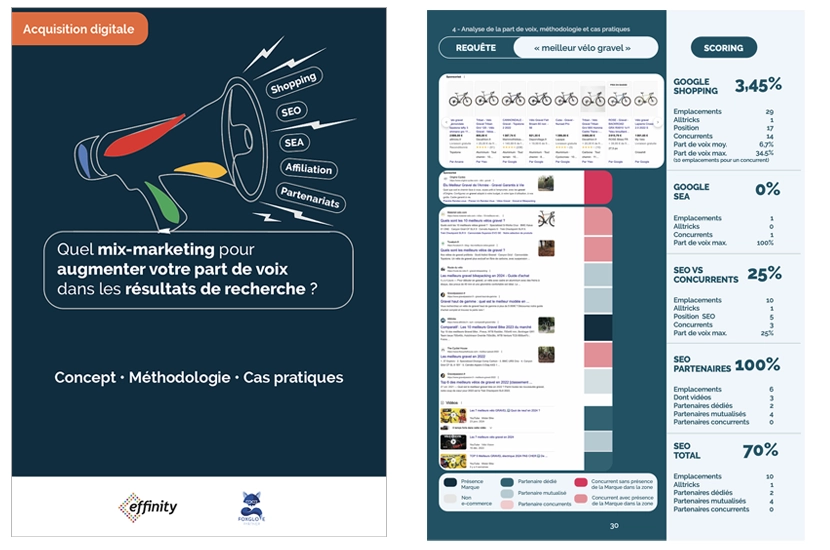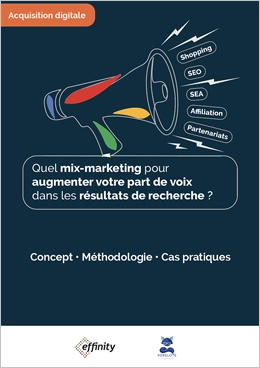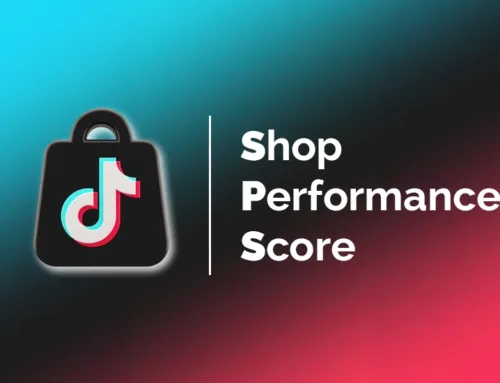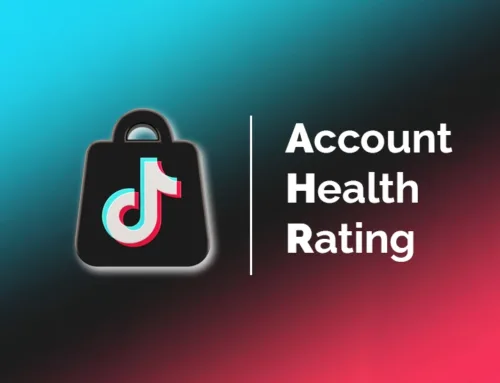- Effinity and SEO agency Foxglove have teamed up to optimize the search engine visibility of their joint client Alltricks.
- This collaboration enabled them to combine their expertise to develop a methodology aimed at optimizing the marketing mix to increase the brand’s share of voice in search results.
- This white paper gives you an insight into this methodology through case studies that you can apply to your brand.
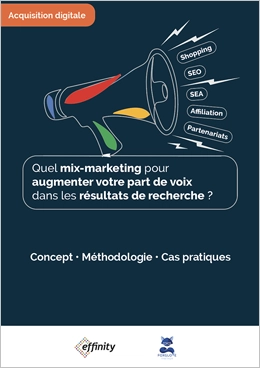
KEY CONCEPTS COVERED BY THE WHITE PAPER
What marketing mix will increase your share of voice in search results?
Why search engines?
Search engines are a key stage in the purchasing process, and a major acquisition lever for e-commerce. Their ability to generate qualified traffic makes them a strategic channel to exploit to the full.
Why the share of voice?
Share of voice measures a brand’s visibility in search results, compared to its competitors. The aim is to occupy as much space as possible, via direct paths (brand presence) or indirect paths (partners or third-party content), in order to maximize conversion opportunities.
What marketing mix?
By analyzing the main areas of search results (Shopping, SEA, SEO), Effinity and Foxglove experts identified levers to activate according to consumers’ intentions. A methodology based on scoring and share-of-voice analysis has emerged. This white paper shares the findings.
WHITE PAPER SUMMARY
Consumers’ disordered buying path
The online consumer purchase journey has become increasingly unpredictable and complex, rendering obsolete traditional models such as the conversion funnel, introduced with the AIDA model at the end of the 19th century. Today’s consumers navigate haphazardly between different points of contact (search engines, social networks, review sites, etc.), making it difficult to understand their path to purchase. With this in mind, Google introduced an alternative model, called the “messy middle”, to represent these unpredictable comings and goings in the buying journey. The result is a graphic description…
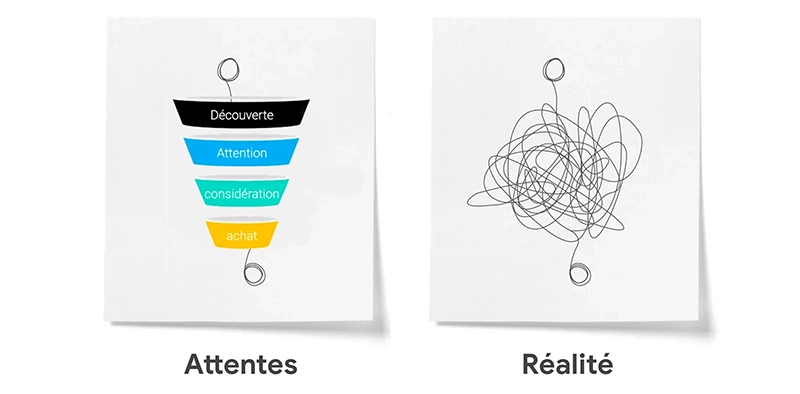
But the experts at Google didn’t stop there. By analyzing multiple purchase paths, they have imagined representing them as an infinite loop, starting with a trigger (a need or a desire) and ending with a purchase. Between these two poles, the consumer alternates between two main phases: exploration, where he gathers a wealth of information, and evaluation, where he gradually narrows down his options. This cycle repeats itself as many times as necessary until a decision is reached.
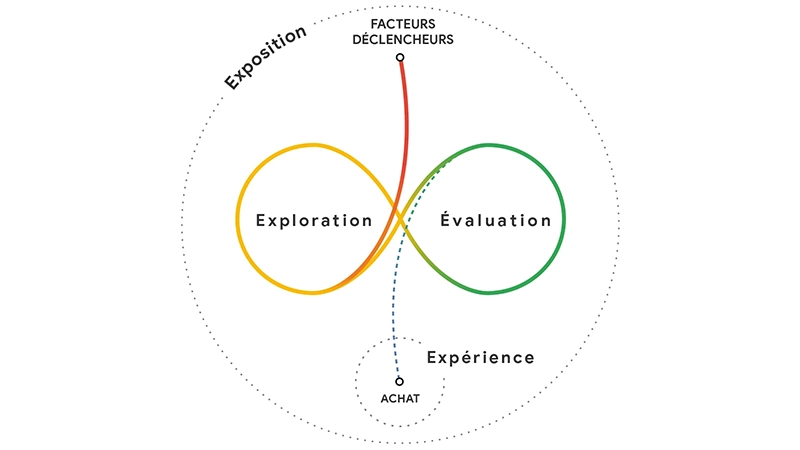
Cognitive biases for moving in the messy middle
Within these exploration and evaluation phases, consumer journeys and choices are influenced by six major cognitive biases:
- Category heuristics, which simplify decision-making by focusing on a few key criteria.
- Authority bias, which values the recommendations of experts or influencers.
- Social proof, based on the opinions and behavior of others.
- The power of the moment, which favors immediacy.
- Scarcity bias, which reinforces the desire for products perceived as rare or limited.
- The power of freebies, attracting consumers with free offers.
To help brands navigate this apparent chaos, Google suggests three best practices:
- ensure a strong brand presence to maximize visibility,
- use cognitive biases ethically to positively influence consumers
- reduce potential buyers’ exposure time to competing offers.
The aim of these strategies is not to simplify the “messy middle”, but to accompany consumers through the entire buying process. In short, the “messy middle” should not be seen as an obstacle, but as an opportunity for brands to better understand consumer behavior and optimize their influence at key moments in the buying journey.
Google searches, the main gateway to the messy middle
In the digital buying journey, Google searches are one of the main gateways to the messy middle. The billions of daily queries are the first steps taken by consumers, guided by the search intent they express. These intentions are translated into queries, classified into three main categories:
- Navigational: aimed at a specific page, often linked to a specific brand or product.
- Informational: seeking answers or information.
- Transactional: they express a willingness to take action, such as buying or reserving.
Search intent modifiers
Google identifies seven main modifiers that reveal consumer intent through the formulation of their queries:
- Ideas: used in the exploration phase to find new inspirations
- Best: depending on its use, it oscillates between exploration and evaluation phases
- Difference between: clarifies the choice between several options
- Cheap: indicates a search for affordable offers, often in the evaluation phase.
- Good deals: explore attractive offers, with or without a brand name
- Opinions: seeking validation through testimonials
- Discount codes: often associated with imminent purchase
Optimizing your presence in the messy middle
For brands, it’s important to be visible throughout the buying journey, without trying to control every step, which would be an illusory goal. Contact points, whether paid (Shopping, SEA) or organic, must be strategically optimized to increase the brand’s presence in the loop.
Google searches thus play a central role in consumers’ entry and journey into the messy middle. Ensuring a diversified presence adapted to different search intentions is essential to capture buyers’ attention and accompany them to their final decision. It’s worth noting that this optimized presence also proves useful in a web-to-store strategy, capturing traffic in search results to generate in-store traffic and sales.
Increase your share of voice in Google search results
Definition and challenges of share of voice in search engines
In an environment where the consumer journey is messy, it’s crucial for brands and e-tailers to be visible in different places and at different times. Google strives to interpret query intent to display the most relevant results. Visibility in search results, known as “share of voice”, is a key indicator to optimize in order to influence consumers in this messy middle ground.
This share of voice represents a brand’s visibility in a given context, in comparison with its competitors. In the context of search engines, it encompasses both paid (SEA, Google Shopping) and organic (direct and indirect SEO) results.
Useful levers for increasing share of voice
Paid leverage : SEA and Google Shopping
Paid results offer immediate visibility, but require rigorous management of budgets and campaigns.
- Google Shopping: Shopping ads appear on relevant product queries. Ranking depends on maximum cost-per-click (CPC) and ad quality (relevance, product data, images). Since the opening of Google Shopping to price comparison services (CSS), brands can exploit this opportunity to optimize their costs.
- Advantages: Top-of-page visibility, precise targeting.
- Disadvantages : High cost, strong competition, constant monitoring required.
- SEA (Search Engine Advertising): Sponsored ads are based on a bidding system in which the relevance of keywords, ads and landing pages plays a crucial role.
- Benefits: Rapid gains in visibility and traffic, detailed targeting.
- Disadvantages: High cost, non-permanent results, continuous optimization required.
Organic levers: direct SEO and partner SEO
SEO levers offer long-term benefits by increasing visibility without the direct cost of clicks.
- Direct SEO: Based on technical optimizations (tags, keywords, internal links) and quality content aligned with search intentions. Positions can evolve according to algorithms and competition.
- Benefits: Sustainable strategy, high long-term ROI, enhanced credibility.
- Disadvantages: Slow results, continuous work required.
- SEO partners: Collaborating with an affiliate marketing platform to work with comparators, blogs, shopping guides, influencers or portals allows you to benefit from their legitimacy and multiply your points of presence on key queries.
- Benefits: Increased visibility via partners, controlled costs thanks to performance-based remuneration.
- Disadvantages: Depends on a well-structured and attractive affiliate program.
Legitimacy: a key factor in share of voice in search results
To maximize its share of voice, a brand needs to conquer three areas of legitimacy: Google, partners and consumers.
- Legitimacy according to Google
Google favors brands it deems expert and relevant to specific search intentions. The creation of a semantic cocoon, with varied and optimized content, helps establish this legitimacy.- Actions: Produce content that meets algorithmic expectations, identify preferred formats (videos, FAQs, blogs) for each search intent.
- Legitimacy according to partners
Partners (comparators, influencers, specialized sites) relay brand offers, reinforcing their visibility and credibility. An effective affiliate program helps recruit these strategic partners.- Actions: Identify relevant partners, diversify formats and collaborations (guides, articles, videos).
- Legitimacy as perceived by consumers
Legitimacy as perceived by consumers is based on brand awareness and trust. This perception influences queries (with or without brand mention) and purchasing behavior.- Actions: Invest in advertising, social networks and positive shopping experiences.
Arbitrating the marketing mix to increase share of voice in search results
The strategy for increasing share of voice on search engines lies in a fine-tuned analysis of legitimacy territories and an appropriate budget allocation. This implies adopting differentiated strategies according to product ranges and the intentions contained in Internet users’ queries. This approach optimizes the marketing mix to maximize visibility, legitimacy and, ultimately, conversions.
Voice share analysis, methodology and case studies
The white paper presents a methodology for analyzing the share of voice in search results, illustrated by the concrete case of Alltricks, a major player in the distribution of bicycles and running equipment. The study focuses on gravel bikes (half mountain bike, half road bike), a particularly dynamic segment.
Query selection
Based on the seven search modifiers described in the messy middle analysis, the queries studied reflect consumer concerns, such as “gravel bike ideas” or “best gravel bike”.
Analysis methodology and indicators
To evaluate Alltricks’ share of voice, the study uses three levers on the results pages:
- Google Shopping
- Analysis of the number of slots available, the brands present, the frequency of Alltricks’ appearance and its average position.
- Calculation of average and maximum share of voice.
- SEA (Search Engine Advertising)
- Evaluation of Alltricks’ presence in sponsored ads, number of placements, and proportion of voice compared to other brands.
- Calculation of average and maximum share of voice.
- SEO (Search Engine Optimization)
- Study of the top 10 SEO results for each query. Pages are classified into six categories, including brands, competitors and partners.
- Detailed calculations: Alltricks’ SEO share of voice versus competitors, share of voice relayed by partners and total share of voice in SEO results.
This methodology provides a comprehensive framework for analyzing a brand’s visibility and identifying the most effective levers based on its position in the results pages. Alltricks was thus able to assess its share of voice in the search results pages and better understand its positioning in relation to its competitors.
By downloading the white paper, you can find the detailed methodology and all the results obtained on the different search intents. This should enable you to analyze your brand’s share of voice.
Mis à jour le 17 June 2025
Mis à jour le 17 June 2025

